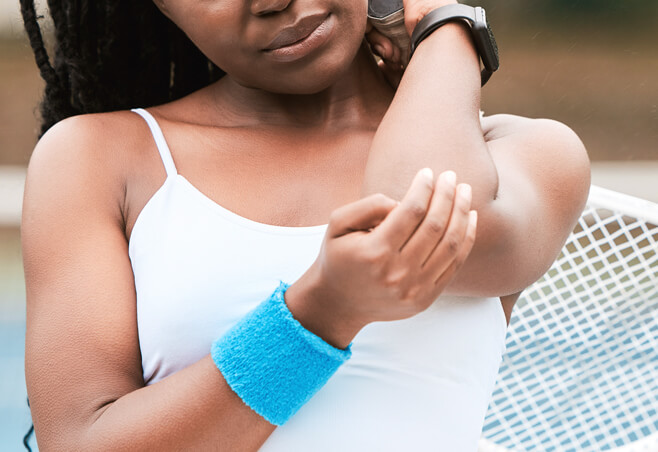Tennis elbow treatment
Lateral epicondylitis
Tennis elbow (lateral epicondylitis) is a condition caused by swelling of the tendons that connect the forearm to the outer side of the elbow. The wear ultimately damages the muscles and tendons from using them over and over again. That is why tennis elbow is an overuse injury. Pain is often experienced on the outer side of the elbow, and the condition can be extremely painful.
While playing tennis can result in this condition, most patients treated for this condition don’t play tennis. Repetitive activities cause the tendons to get overworked, causing small tears.
To prevent this type of overuse injury, you simply have to not overuse it. If you start to have pain in the lateral side of the elbow (tennis elbow), the best way to try to avoid the pain is to do things with the palm-up position. By putting your palm up, you transfer the forces from the hand to the medial side of the elbow.
Your physician will work with you to determine the best possible approach to your care.
Treatment
Patients with tennis elbow are best treated non-operatively. Depending upon the nature and extent of the inflammation, there are many treatment options available which are successful in 80% to 90% of tennis elbow cases.
Conservative, nonsurgical treatments
- Relaxation – Stop the activities that are causing the pain. Your pain is telling you to rest the muscles by taking a timeout from using it. You will need to take a break from taking part in sports as well as refraining from heavyweight activities.
- Anti-inflammatory medications – Either over-the-counter (Ibuprofen and aspirin) or prescription anti-inflammatory medications can reduce swelling and pain.
- Equipment inspection – If you use a tennis racquet regularly, have it professionally inspected to ensure the size or weight of the racquet is appropriate.
- Topical compound creams – These can be rubbed onto the affected area.
- Physical therapy – Exercises that concentrate on reinforcing the forearm muscles are beneficial.
- Muscle stimulating procedures – Prescribed by your doctor and physical therapist improve the healing of the tendons. Ultrasound and massaging with ice also help.
- Bracing – A brace can also ease symptoms.
For those patients who fail the most conservative measures over roughly three months, sometimes cortisone and biologic injections are used.
Surgical treatments
As always, your Florida Orthopaedic Institute surgeon will exhaust all applicable nonsurgical healing methods before advising surgery. Surgical intervention may be recommended if the pain continues and all conservative methods have been exhausted after approximately a year. If surgery is required, it is typically used to eliminate unhealthy tissue and connect healthier muscle to the bone.
The right surgical approach for you will depend on a range of factors. These include the scope of your injury, your general health, and your personal needs. Your Florida Orthopaedic Institute surgeon can discuss all the options.

Related specialties
- Arthroscopic Debridement of the Elbow
- Aspiration of the Olecranon Bursa
- Cubital Tunnel Syndrome
- Elbow Bursitis
- Elbow Injuries & Inner Elbow Pain in Throwing Athletes
- Golfer's Elbow
- Growth Plate Injuries of the Elbow
- Hyperextension Injury of the Elbow
- Little Leaguer's Elbow (Medial Apophysitis)
- Olecranon Stress Fractures
- Radial Tunnel Syndrome
- Tricep Pain & Tendonitis
- UCL (Ulnar Collateral Ligament) Injuries
- Valgus Extension Overload
